Subaru Corporation Bundle
Who Really Drives Subaru Corporation?
Unveiling the ownership structure of Subaru Corporation is like peering under the hood of its strategic engine. Understanding "Who owns Subaru" is crucial for anyone looking to navigate the automotive market. From its roots as Fuji Heavy Industries to its current global presence, the ownership story of Subaru is a fascinating journey. This exploration reveals how these stakeholders influence the company's direction and future.
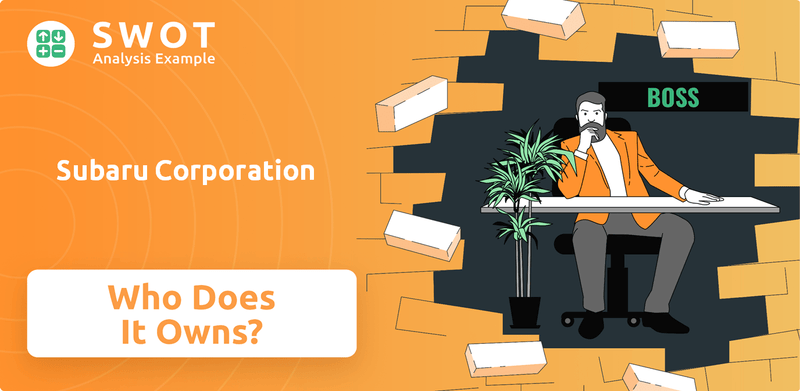
Delving into the Subaru Corporation SWOT Analysis, we find that understanding the company's ownership provides critical insights into its strengths and weaknesses. Knowing "Who owns Subaru" helps unravel the dynamics of Subaru's strategic decisions, especially concerning its parent company and major shareholders. Examining the evolution of Subaru's ownership, including its relationship with Toyota, offers a comprehensive view of its market position and future prospects. This analysis is essential for investors and strategists alike, seeking to understand the forces shaping this prominent Japanese automaker.
Who Founded Subaru Corporation?
The story of Subaru Corporation begins with Nakajima Aircraft Company, established in 1917 by Chikuhei Nakajima. After World War II, the company underwent restructuring, leading to the formation of Fuji Heavy Industries (FHI) in 1953, which would later become Subaru Corporation. This transition marked the beginning of the automotive venture we know today.
The early ownership of Subaru Corporation, then FHI, was a result of the merger of five different companies: Fuji Kogyo, Fuji Jidosha Kogyo, Omiya Fuji Kogyo, Utsunomiya Sharyo, and Tokyo Fuji Sangyo. While specific equity breakdowns from the initial formation aren't widely available in public records, the structure indicates a distribution among the stakeholders of these predecessor entities.
The consolidation into Fuji Heavy Industries was designed to harness the combined manufacturing expertise of the constituent companies, especially within the growing automotive sector. Initial financial backing came from the assets and capital of these merging entities. The focus was on integrating operations and shareholdings, establishing the foundation for the unified corporate structure. The founding team's vision was to create a diversified industrial giant, encompassing automotive, aerospace, and industrial products, reflected in this broad consolidation of manufacturing capabilities.
Subaru Corporation's roots are in the Nakajima Aircraft Company, founded in 1917. The company was reorganized after World War II.
In 1953, Fuji Heavy Industries (FHI) was formed from five companies. These included Fuji Kogyo, Fuji Jidosha Kogyo, and others.
Early ownership was distributed among the stakeholders of the merging entities. The merger aimed to leverage combined manufacturing experience.
The founding team aimed for a diversified industrial giant. This included automotive, aerospace, and industrial products.
Initial financial support came from the assets and capital of the merging companies. No angel investors or family stakes are widely documented.
Early agreements focused on integrating operations and shareholdings. This laid the groundwork for the unified corporate structure.
The evolution of Subaru ownership has seen significant changes over time. The relationship with Toyota is a key aspect of the current Subaru Corporation. For more insights into Subaru's market position, you can read about the Target Market of Subaru Corporation.
Subaru Corporation's origins are tied to the Nakajima Aircraft Company.
- Fuji Heavy Industries (FHI) was formed in 1953.
- Early ownership was distributed among the merging companies.
- The focus was on creating a diversified industrial company.
- Toyota's involvement has shaped the current ownership structure.
Subaru Corporation SWOT Analysis
- Complete SWOT Breakdown
- Fully Customizable
- Editable in Excel & Word
- Professional Formatting
- Investor-Ready Format
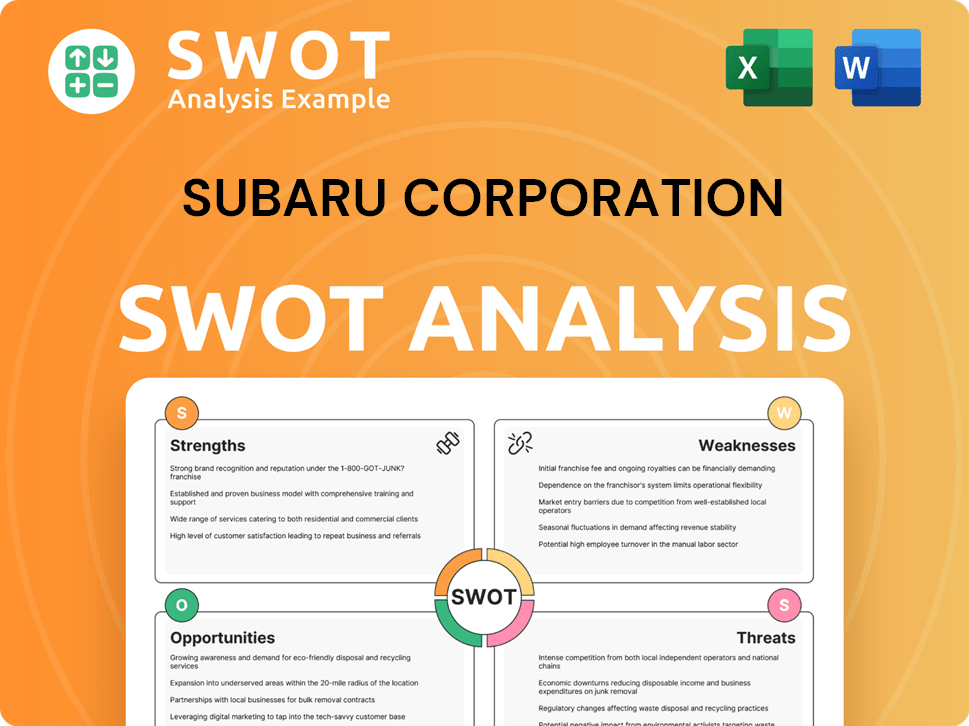
How Has Subaru Corporation’s Ownership Changed Over Time?
The evolution of Subaru Corporation's ownership has been marked by strategic alliances and shifts in major stakeholders. Initially known as Fuji Heavy Industries (FHI), the company saw Nissan Motor Co. acquire a 20% stake in 1968, aiming to strengthen their positions in the automotive market. This partnership was followed by a significant change in 1999 when General Motors (GM) acquired a 20% stake from Nissan, which later increased to 20.1% by 2000. These alliances facilitated joint ventures and technology sharing, particularly in North America.
A pivotal change occurred in 2005 when GM divested its entire stake in FHI. Toyota Motor Corporation then stepped in, acquiring an initial 8.7% from GM. This marked the beginning of a deepening strategic partnership. Toyota's stake steadily increased over the years, reaching 16.5% by 2008. In 2019, Toyota further solidified its position, increasing its stake to 20%, making it the largest single shareholder. This move underscored a strong collaboration in technology, especially in electric vehicles and autonomous driving. As of early 2025, Toyota Motor Corporation remains the primary shareholder, holding approximately 20% of Subaru Corporation's shares.
| Year | Event | Impact on Ownership |
|---|---|---|
| 1968 | Nissan acquires stake in FHI | Nissan held a 20% stake |
| 1999 | GM acquires stake in FHI | GM held a 20% stake |
| 2005 | Toyota acquires stake from GM | Toyota's initial stake: 8.7% |
Besides Toyota, other major stakeholders include institutional investors, mutual funds, and index funds, which collectively hold a substantial portion of the publicly traded shares. While the specific percentages held by these entities fluctuate with market activity, their influence on governance through voting power is significant. The transition from alliances with Nissan and GM to a deep partnership with Toyota has significantly influenced Subaru's strategic direction, especially in product development, manufacturing, and global market expansion. This shift has positioned Subaru to leverage Toyota's technological advancements and market reach.
Toyota Motor Corporation is the majority shareholder of Subaru Corporation, holding approximately 20% of the shares as of early 2025.
- Subaru's ownership has evolved through partnerships with Nissan, GM, and Toyota.
- Institutional investors also play a significant role in Subaru's ownership structure.
- The strategic partnership with Toyota is critical for Subaru's future, particularly in EVs and autonomous driving.
Subaru Corporation PESTLE Analysis
- Covers All 6 PESTLE Categories
- No Research Needed – Save Hours of Work
- Built by Experts, Trusted by Consultants
- Instant Download, Ready to Use
- 100% Editable, Fully Customizable
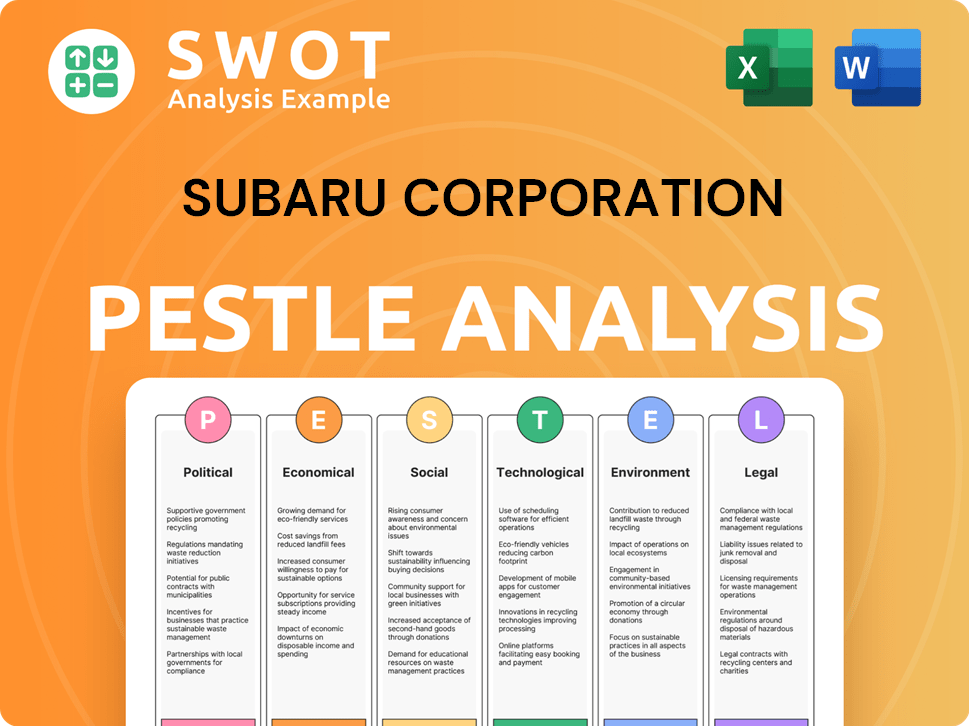
Who Sits on Subaru Corporation’s Board?
The Board of Directors of Subaru Corporation, as of early 2025, oversees the company's operations and strategic direction. The board typically includes a mix of executive directors, who are part of the management team, and external or independent directors. The composition of the board can change, but major shareholders, such as Toyota Motor Corporation, often have representation or influence, reflecting their significant ownership stake. This structure ensures a balance of perspectives in the company's governance.
The board's role is crucial in representing the interests of all Subaru shareholders. Decisions are usually made through consensus, with a focus on long-term growth and sustainability. This approach is particularly important in areas like electrification and advanced safety features, where strategic alignment with Toyota is key. The board's decisions are influenced by the company's ownership structure and the dynamics among its shareholders.
| Board Member | Title | Affiliation |
|---|---|---|
| Tomomi Nakamura | Chairman of the Board | Subaru Corporation |
| Atsushi Osaki | President and CEO | Subaru Corporation |
| Tetsuo Fujinuki | Director | Toyota Motor Corporation |
Subaru Corporation operates under a one-share-one-vote structure for its common shares, meaning each share has equal voting rights. The company generally promotes a democratic voting process among shareholders. The stable relationship with Toyota, the largest shareholder, contributes to a relatively harmonious governance environment. Toyota's roughly 20% ownership gives it significant influence in board appointments and strategic decisions.
The Board of Directors plays a key role in Subaru's operations. The board includes both executive and independent directors. Toyota's significant stake influences board appointments and strategic decisions.
- The board structure balances executive and independent directors.
- Toyota's influence is significant due to its large shareholding.
- Decisions are made through consensus, focusing on long-term growth.
- Subaru's governance promotes a democratic voting process.
Subaru Corporation Business Model Canvas
- Complete 9-Block Business Model Canvas
- Effortlessly Communicate Your Business Strategy
- Investor-Ready BMC Format
- 100% Editable and Customizable
- Clear and Structured Layout
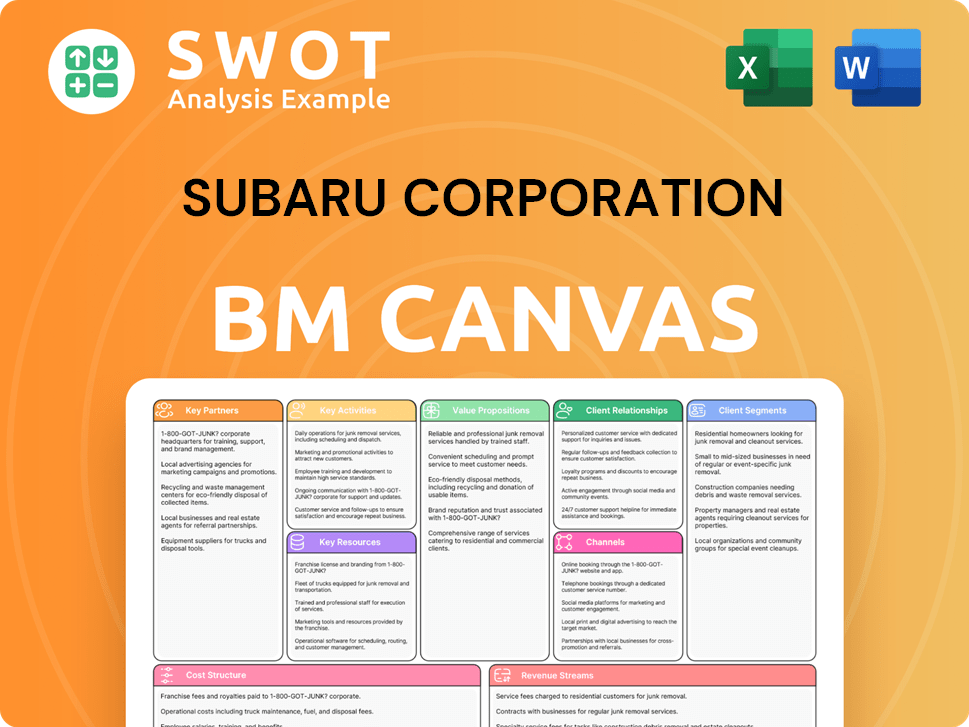
What Recent Changes Have Shaped Subaru Corporation’s Ownership Landscape?
In the past few years, from 2022 to 2025, the ownership structure of Subaru Corporation has remained largely consistent, with Toyota Motor Corporation holding a significant stake. This strategic partnership between the two companies continues to be a key aspect of Subaru's operations. Toyota's approximately 20% ownership has been a cornerstone, fostering collaboration in technology and production, particularly in the development of electric vehicles like the Solterra, which shares a platform with Toyota's bZ4X.
While the major shareholders haven't seen substantial changes, fluctuations in institutional ownership are likely. This is a common trend in mature markets, where large funds and asset managers seek exposure to established companies. Founder dilution has naturally occurred over time, with no single founder or family maintaining a controlling stake. The company operates as a publicly listed entity on the Tokyo Stock Exchange.
| Ownership Category | Approximate Percentage | Notes (as of early 2024) |
|---|---|---|
| Toyota Motor Corporation | ~20% | Strategic partnership and collaboration in EV development. |
| Institutional Investors | Variable | Fluctuations based on market trends and investment strategies. |
| Public Shareholders | Remainder | Includes individual and other institutional investors. |
The strong partnership with Toyota is viewed positively by analysts, offering Subaru access to resources and scale. For more insights, explore the Growth Strategy of Subaru Corporation.
The strategic alliance between Subaru and Toyota remains a core aspect of Subaru's ownership and operational strategy. This partnership is crucial for Subaru's expansion, especially in the rapidly evolving EV market. The collaboration allows both companies to share resources and expertise.
Institutional ownership is subject to market dynamics, with fluctuations common among publicly traded companies. Subaru's shares are traded on the Tokyo Stock Exchange. The ownership structure reflects industry trends.
Subaru Corporation Porter's Five Forces Analysis
- Covers All 5 Competitive Forces in Detail
- Structured for Consultants, Students, and Founders
- 100% Editable in Microsoft Word & Excel
- Instant Digital Download – Use Immediately
- Compatible with Mac & PC – Fully Unlocked
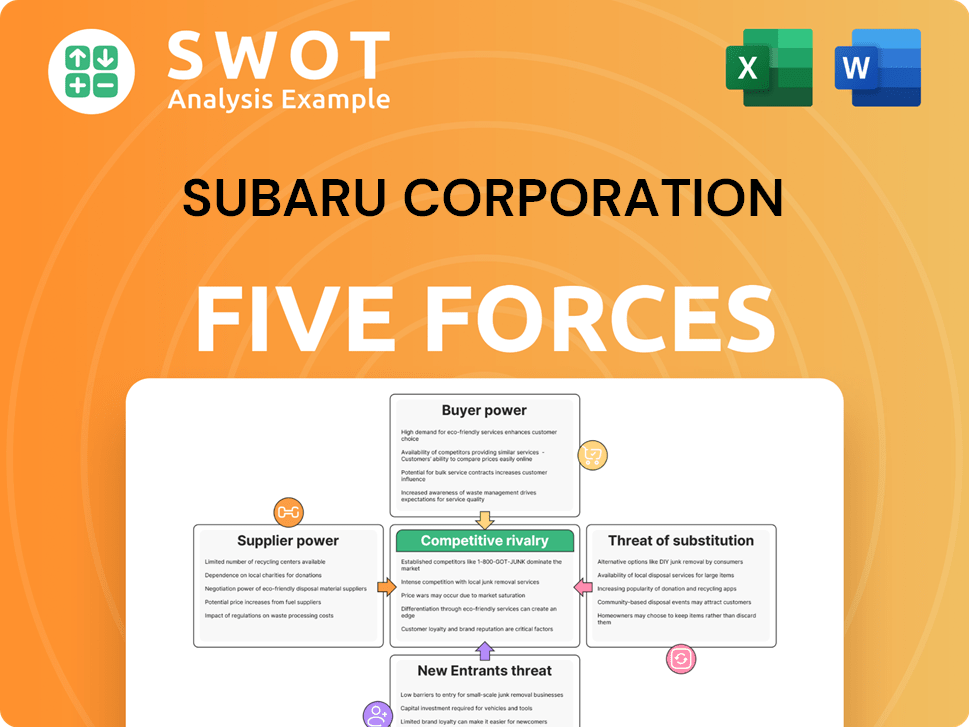
Related Blogs
- What are Mission Vision & Core Values of Subaru Corporation Company?
- What is Competitive Landscape of Subaru Corporation Company?
- What is Growth Strategy and Future Prospects of Subaru Corporation Company?
- How Does Subaru Corporation Company Work?
- What is Sales and Marketing Strategy of Subaru Corporation Company?
- What is Brief History of Subaru Corporation Company?
- What is Customer Demographics and Target Market of Subaru Corporation Company?
Disclaimer
All information, articles, and product details provided on this website are for general informational and educational purposes only. We do not claim any ownership over, nor do we intend to infringe upon, any trademarks, copyrights, logos, brand names, or other intellectual property mentioned or depicted on this site. Such intellectual property remains the property of its respective owners, and any references here are made solely for identification or informational purposes, without implying any affiliation, endorsement, or partnership.
We make no representations or warranties, express or implied, regarding the accuracy, completeness, or suitability of any content or products presented. Nothing on this website should be construed as legal, tax, investment, financial, medical, or other professional advice. In addition, no part of this site—including articles or product references—constitutes a solicitation, recommendation, endorsement, advertisement, or offer to buy or sell any securities, franchises, or other financial instruments, particularly in jurisdictions where such activity would be unlawful.
All content is of a general nature and may not address the specific circumstances of any individual or entity. It is not a substitute for professional advice or services. Any actions you take based on the information provided here are strictly at your own risk. You accept full responsibility for any decisions or outcomes arising from your use of this website and agree to release us from any liability in connection with your use of, or reliance upon, the content or products found herein.